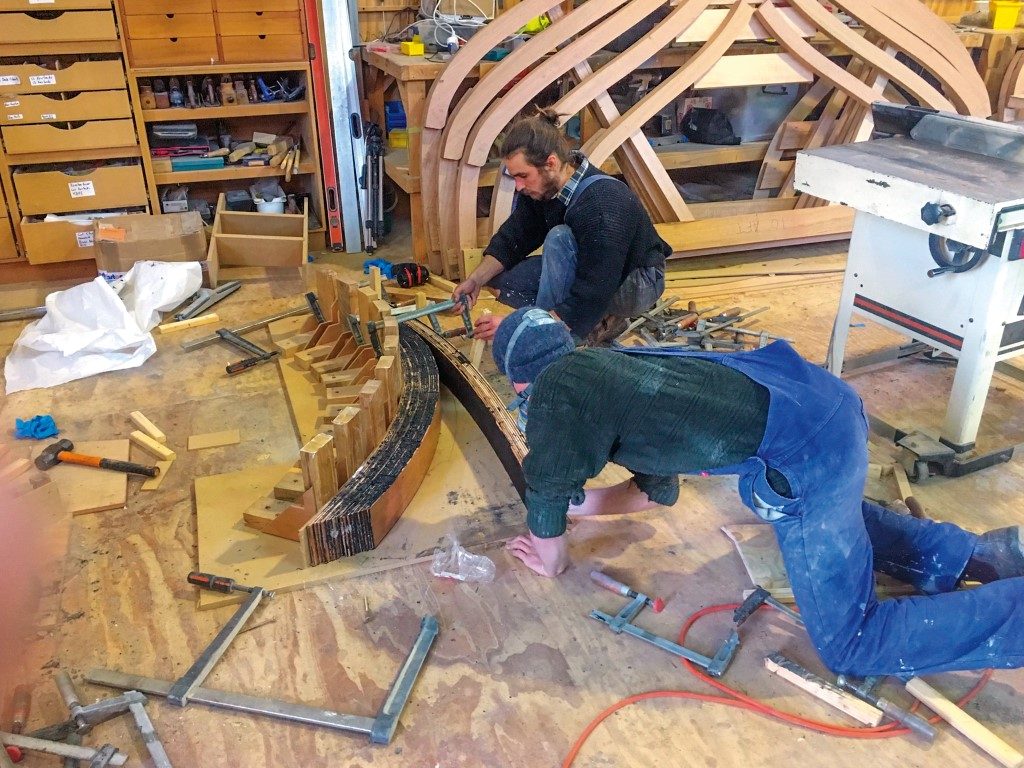

Built in the early 1920s in Germany, the iconic 32-foot double-ended ketch Te Rapunga is enjoying a complete restoration by Tasmanian wooden boat specialist Denman Marine. She will return to her natural element in time for the island’s Wooden Boat Festival in February next year.
Te Rapunga (‘longing for the dawn’ in Maori) was discovered in an Auckland front yard in 2018 after some 20 years on dry land. She was bought by a Bruny Island tourism group – together with some sailing enthusiasts. The restoration, they believe, will shine a light on the remarkable life and philosophy of German-born seafarer and ‘citizen of the world’, George Dibbern.
But the job is going to a quite a bit tougher than initially envisaged, says Denman Marine’s Andrew Denman. “Our survey found she was too far gone – she would require a complete rebuild.”
The project is being supported by a team of shipwrights – with additional guidance from Erika Grundman, the author who researched and wrote Dibbern’s biography – Dark Sun: Te Rapunga & the Quest of George Dibbern.
The vessel will be planked in huon pine and celery-top pine over hardwood frames. One concession to modern materials is the use of WEST SYSTEM epoxy for deck beam lamination and other laminated hardwood components. The glue’s renowned for its “reliability and cold weather curing,” says Denman.
WEST SYSTEM is a structural marine adhesive and often stronger than the wood being bonded. It has been used around the world for timber boat repairs for over 50 years and is ideal for repairing existing damage and reducing flexing. It also serves as a moisture barrier.

The project is on track to be completed by end of the year, with the aim is to sail her into the Wooden Boat Festival in February 2021. The owners say the objective is to bring the venerable vessel back to life and share her adventures with Festival visitors, telling her story online and in the flesh as she travels.
“The sea epitomises island life, wooden boats and the tradition of exploration. Seafaring vessels have always been crucial to Bruny Island, connecting it, at times in surprising ways, to a world otherwise so isolated from it,” says Denman.
“We felt that this little ‘bathtub of a boat’, the vessel of Dibbern’s spiritual quest, deserves a better fate than to languish in a suburban yard. So we’ve taken up the challenge to refloat Te Rapunga and bring her to Tasmania where the art of wooden boatbuilding still burns brightly. This project is a joint celebration of both the boat’s restoration and the craft that makes her salvation possible.”
Dibbern’s story is at the heart of the voyages of the Te Rapunga. A merchant sailor prior to WWI, he set sail with a crew of three from Keil, Germany in 1930. Describing himself as a “citizen of the world and a friend of all peoples”, he renounced his German citizenship, created his own passport and flew a flag of his own creation.
Between 1930 and 1934 Te Rapunga travelled through the Mediterranean, crossed the Atlantic, sailed the Panama Canal and on to San Francisco, Honolulu, Samoa, eventually landing in Auckland.
Dibbern’s deep connection with Tasmania began in 1934 when Te Rapunga was invited to compete in the second Trans-Tasman Yacht race from Auckland to Melbourne. She completed it in 19 days after the boat sprang a leak early on in some “boisterous” weather. The repair delayed her by 44 hours. But she went on to take line honours from the only other competitor in the race – Johnny Wray with Ngataki.

After Dibbern’s death in 1962 Te Rapunga passed into various hands before ending up in storage. The Bruny Island consortium is motivated to share his message of harmony and inclusion.
“In a world of growing political polarisation and discord, we feel his message of global citizenship and his life’s purpose is a bridge of goodwill. It is particularly pertinent and could do with some amplification,” says Denman.
“In the vein of the early explorers, naturalists and expeditioners, we are setting sail in our little bathtub of a boat on a voyage of discovery, not knowing where the journey will take us or what we will learn.”




